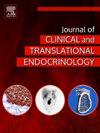目标血糖在140 ~ 180 mg/dL范围内的时间与糖尿病危重患者死亡率的关系:MIMIC-IV数据库的分析
IF 3.3
Q1 ENDOCRINOLOGY & METABOLISM
Journal of Clinical and Translational Endocrinology
Pub Date : 2025-07-22
DOI:10.1016/j.jcte.2025.100413
引用次数: 0
摘要
范围内时间(TIR)是一种血糖控制指标,与糖尿病预后的关系越来越密切。对于危重型高血糖患者,建议将目标血糖控制在140-180 mg/dL。方法本队列研究分析来自MIMIC-IV数据库的6047例危重糖尿病患者(中位年龄68岁,男性62.3%)。TIR (140-180 mg/dL)定义为24小时内血糖在目标范围内的时间百分比。按TIR四分位数对患者进行分层。结果包括全因死亡率、ICU死亡率、住院死亡率和28天死亡率。Cox模型评估了tir -结局的关系。结果TIR越高,死亡率越低。全因死亡率的调整hr分别为1.00 (Q1)、0.63 (Q2)、0.56 (Q3)和0.65 (Q4) (p为趋势和lt;0.001)。院内死亡率也出现了类似的趋势(第四季度vs第一季度:HR 0.79, 95% CI: 0.64-0.97)。TIR每增加10%,全因死亡率降低8% (HR 0.92, 95% CI: 0.88-0.95)。非线性剂量-反应关系显著(p <;0.001),对患者的影响更强<;60例,男性,以及有心肌梗死或癌症病史者(p为相互作用<;0.05)。结论较高的TIR (140 ~ 180 mg/dL)可降低危重糖尿病患者的死亡率,提示TIR是ICU血糖管理的一个有价值的指标。本文章由计算机程序翻译,如有差异,请以英文原文为准。
Association of the time in targeted blood glucose range of 140 to 180 mg/dL with the mortality of critically ill patients with diabetes: analysis of the MIMIC-IV database
Background
Time in range (TIR), a glycemic control metric, is increasingly linked to diabetes outcomes. A target of 140–180 mg/dL is recommended for critically ill hyperglycemic patients.
Methods
This cohort study analyzed 6,047 critically ill diabetic patients (median age 68, 62.3 % male) from the MIMIC-IV database. TIR (140–180 mg/dL) was defined as the percentage of time within the target glucose range over 24 h. Patients were stratified by TIR quartiles. Outcomes included all-cause mortality, ICU mortality, in-hospital mortality, and 28-day mortality. Cox models assessed TIR-outcomes relationships.
Results
Higher TIR correlated with lower mortality. Adjusted HRs for all-cause mortality were 1.00 (Q1), 0.63 (Q2), 0.56 (Q3), and 0.65 (Q4) (p for trend < 0.001). Similar trends were observed for in-hospital mortality (Q4 vs. Q1: HR 0.79, 95% CI: 0.64–0.97). Each 10 % TIR increase reduced all-cause mortality by 8 % (HR 0.92, 95 % CI: 0.88–0.95). Nonlinear dose–response relationships were significant (p < 0.001), with stronger effects in patients < 60, males, and those with myocardial infarction or cancer history (p for interaction < 0.05).
Conclusions
Higher TIR (140–180 mg/dL) is associated with reduced mortality in critically ill diabetic patients, suggesting that TIR is a valuable metric for glycemic management in the ICU.
求助全文
通过发布文献求助,成功后即可免费获取论文全文。
去求助
来源期刊

Journal of Clinical and Translational Endocrinology
ENDOCRINOLOGY & METABOLISM-
CiteScore
6.10
自引率
0.00%
发文量
24
审稿时长
16 weeks
 求助内容:
求助内容: 应助结果提醒方式:
应助结果提醒方式:


